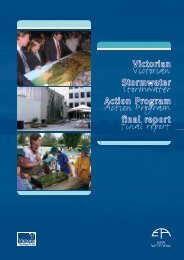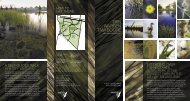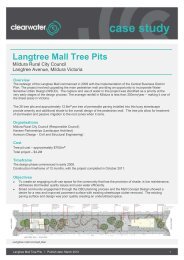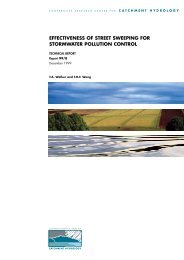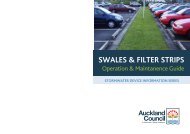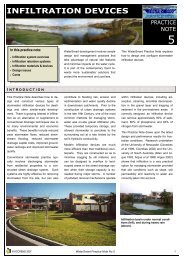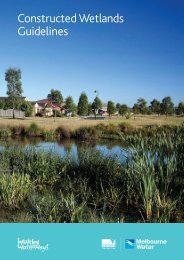Hydraulic performance of biofilter systems for stormwater management
Hydraulic performance of biofilter systems for stormwater management
Hydraulic performance of biofilter systems for stormwater management
You also want an ePaper? Increase the reach of your titles
YUMPU automatically turns print PDFs into web optimized ePapers that Google loves.
saturated, we can then assume that the wetting front is going down the drainage layer<br />
and will be as thick as the soil layer and there will be no pressure in the drainage layer<br />
(ie. free drainage is assumed).<br />
Darcy’s law (Eq. 4) can be then used to calculate the hydraulic conductivity.<br />
QL<br />
K fs =<br />
( H LA )<br />
+<br />
Eq. 4<br />
Where L - the length <strong>of</strong> the media filter, H - the ponding depth, Q - the infiltration flow<br />
rate (i.e., added volume <strong>of</strong> water to keep a constant head divided by the time step) and A<br />
the cross sectional area <strong>of</strong> the column.<br />
The cylinder used had a 130 mm internal diameter and was driven up to the gravel<br />
layer. This method is able to measure the hydraulic conductivity <strong>of</strong> the whole system,<br />
and can thus account <strong>for</strong> a limiting layer anywhere in the media depth pr<strong>of</strong>ile.<br />
Laboratory infiltration test<br />
Soil samples were tested according to the Australian standard AS 4419-2003.<br />
Tests were undertaken on disturbed samples (by necessity). Surface samples (called labsurface)<br />
were taken in the first centimetre <strong>of</strong> the soil and deep samples between 10 and<br />
15 cm. Surface samples were used to compare the field and the laboratory method. Deep<br />
samples (called lab-deep) are assumed to represent ‘the initial hydraulic conductivity’<br />
<strong>of</strong> the <strong>systems</strong> because soil has not been changed by sediment deposit (any fine<br />
sediment deposited on the filter is assumed to be trapped within the first few<br />
centimetres <strong>of</strong> the media (Hatt et al, 2006). The dimensions <strong>of</strong> samples tested during the<br />
experiments were 100 mm diameter and 85 mm deep.<br />
Limitations <strong>of</strong> the sampling methods<br />
For both field tests, the main limitations are the possible compaction or<br />
disturbance <strong>of</strong> the soil while the ring is driven into the soil and possible preferential<br />
flow on the side <strong>of</strong> the column. For the deep ring method, it is also possible that the<br />
assumptions <strong>of</strong> saturated conditions at the beginning <strong>of</strong> the experiment, and the freedraining<br />
behaviour <strong>of</strong> the underlying gravel, may not be true in all cases.<br />
12




